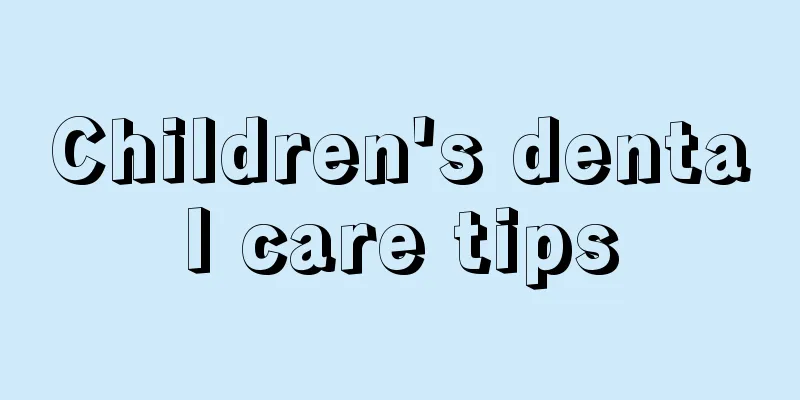What is the correct way to care for your baby's face?

|
Children are the treasures of their mothers. Many mothers pay special attention to their children's affairs, especially when their children are infants. Many mothers don't know how to help their children clean themselves, so they are often in a panic. But at the same time, babies will cry because of their mothers' rudeness. The following will teach you how to correctly help babies with facial care. 1. General care and cleaning of face and facial area 1. Prepare the materials A special washbasin for babies (with half a basin of warm water, the water temperature is 38~43℃). Place two soft cotton towels, a bottle of baby shampoo, a pack of sterilized cotton swabs, a teapot (with warm water), a small plate for dirt, a pair of small scissors, and some clean tops in the nursing basket. 2. Operation method Hold the newborn with your left arm, and clamp the child's hips and lower limbs with your left elbow and waist. Support the head and neck with your left hand, and press the baby's ears with your thumb and middle finger so that the auricle covers the external auditory canal to prevent face washing water from entering the ear canal and causing inflammation. Wet a small towel with your right hand, squeeze it slightly, and wash your eyes first. Note that after wiping one eye with the towel, you should change side and wipe the other eye. Then rinse the towel in water, wipe your forehead, cheeks and corners of your mouth, wring out the towel and wipe your face dry. 3. Then wash your hair First, pour a little baby shampoo into your hands and gently rub it on your head, being careful not to let it get into your eyes or ear canals. Finally, ask another person to help rinse your hair with warm water from a small teapot and dry it. Then scrub your neck, underarms, forearms and hands. Most newborns keep their hands tightly clenched into fists. If they are not washed and dried, the skin on the palms will easily become eroded. After washing and changing the baby into clean clothes, pick up the baby and use a sterilized cotton swab to wipe off the baby's nasal secretions and water stains in the external auditory canal. Be careful to be gentle and do not insert the cotton swab deep into the nasal cavity and ear canal. Just treat the outside. Notice: Because the skin of newborns is particularly delicate and their immune mechanisms are not yet fully established, the slightest damage to the skin can lead to infection. If not handled properly, severe cases may lead to sepsis. Therefore, when wiping the body with a towel, be sure to be gentle and it is best to use a dry towel to absorb moisture. 2. Other care for infants 1. Eye care If bath liquid or soapy water accidentally gets into the baby's eyes, rinse the eyes. (1) Prepare supplies: Place a small teapot with a thin neck filled with warm water, a pack of sterilized cotton swabs, a small plate for waste, a washbasin for collecting water, and a bottle of 0.25% chloramphenicol eye drops in the nursing basket. (2) Operation steps: Two people are required to work together. One person holds the baby. If you want to rinse the left eye, tilt the baby's head to the left and place a basin on the ground under the baby's head. Use your right hand to separate the upper and lower eyelids of the baby's left eye. The other person holds the spout of a small pot with a thin neck about 1 to 2 cm away from the baby's head, then tilts the pot slightly to allow the water to slowly rush towards the baby's eyes. Be careful not to let water flow into the ear canal when flushing. The water temperature should not be too high. The water pressure should not be too high when flushing to avoid damaging the baby's eye tissue. After rinsing, use a sterilized cotton swab to absorb all water stains around the eyes. If necessary, rinse the other eye in the same way, and then put 1 to 2 drops of 0.25% chloramphenicol eye drops in each eye. 2. Nose care: The nasal mucosa of newborn babies is soft and rich in blood vessels. It is easy to become congested and edematous when encountering slight stimulation, making the originally narrow nasal cavity even narrower, resulting in difficulty breathing and irritability. In addition, nasal secretions are also an important cause of nasal congestion in newborns. (1) Prepare supplies: Place a pack of sterilized cotton swabs and a bowl of clean water in the nursing basket. (2) Operation steps: When cleaning nasal secretions, do not use tweezers to pinch them out forcefully. Soften the nasal crust first, then use a cotton swab dipped in clean water to drop 1 to 2 drops into each nasal cavity, or use breast milk or milk. After 1 to 2 minutes, wait for the nasal crust to soften and then use a dry cotton swab to pull it out, or use a soft object to stimulate the nasal mucosa to induce sneezing. The nasal secretions will then be discharged, thus making the newborn's nasal cavity unobstructed. 3. Ear care The ear shell of a full-term newborn is fully formed, but the external auditory canal is relatively narrow. Once sewage flows deep into the ear canal, it can easily cause inflammation, and in severe cases, it can cause furunculosis in the external auditory canal. Because the skeleton of newborns is not fully developed, the external auditory canal is almost a slit. When inflammation occurs, the nerves are compressed and stimulated severely, so the pain is more severe. The newborns will cry and be restless, and have difficulty sleeping at night. Holding and coaxing them are ineffective. In short, if a newborn baby often cries and is restless, inflammation of the external auditory canal is also one of the reasons. Therefore, whether you are washing your newborn's hair, bathing him or putting eye drops in, be careful not to let dirty water, liquid medicine, etc. flow deep into the ear canal. Once external ear canal inflammation occurs, you should go to the hospital for medical treatment in time, take medicine and drops on time, and apply local hot compresses. As long as the treatment is proper, the disease will heal well. (1) Prepare supplies: Place the required medicine in the nursing basket, a pack of sterilized cotton swabs, a small dish for waste, and a bottle of 3% hydrogen peroxide or saline. (2) Operation steps: After washing hands, the operator places the newborn on its side with the affected ear facing upwards, and gently wipes the external auditory canal secretions with a sterile cotton swab. If necessary, clean the external auditory canal with normal saline or 3% hydrogen peroxide. Use the left hand to pull the auricle, and use the right hand to drop 3 to 5 drops of medicine into the back wall of the ear canal with a dropper or dropper. Gently press the tragus to allow the medicine to slowly flow into the ear along the ear canal wall. The baby should remain in this position for about 5 minutes. Note that the temperature of ear drops should be close to body temperature (37.7℃ is appropriate) to avoid stimulating the labyrinthine nerve and causing adverse reactions such as dizziness and nausea. When dropping the medicine, hold the auricle with one hand and pull it backward and downward to make the external auditory canal vertical so that the medicine can enter the deep part of the external auditory canal smoothly. |
<<: What are the effective methods to treat children's cough?
>>: Eight reasons why children have excessive lead levels
Recommend
What are the medicines for bed-wetting?
Bedwetting can happen at any age, but the highest...
What should a baby eat to stimulate his appetite if he has a poor appetite?
Traditional Chinese medicine believes that people...
What to do if your child refuses to take a bottle
We all know that breast milk is the best for babi...
How many days does a baby's viral fever last?
When a baby has a fever, we usually have to find ...
What are the ways to deal with moderate myopia in children?
Today's students are under increasing pressur...
What to do if your 2-year-old baby has eczema
An inexperienced mother may not know at first tha...
What are the symptoms of iron deficiency in children?
As we all know, human life activities require the...
Why do children have cold hands and feet?
We know that young children's bodies are rela...
Can a one-year-old child eat yogurt?
A one-year-old child can no longer meet his needs...
What should I do if my child has eye inflammation? These methods can help mothers
Every parent hopes that the baby can grow up heal...
What is the procedure for tongue cutting surgery in children?
The tongue tendons that people often talk about a...
Is it normal for a 7-year-old to fart frequently?
Farting is a very common phenomenon in our lives....
What causes the child's swollen eyes?
In daily life, parents are very concerned about t...
How to solve the problem of small blisters on children's fingers
Small blisters on children's fingers may be a...
The child has a stuffy nose and snores
The baby's body resistance is poor, and they ...









